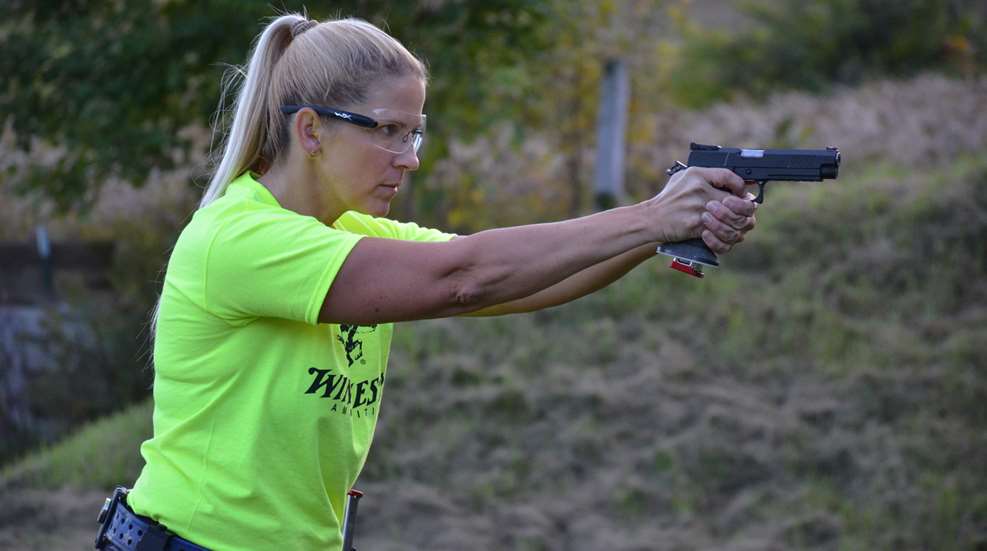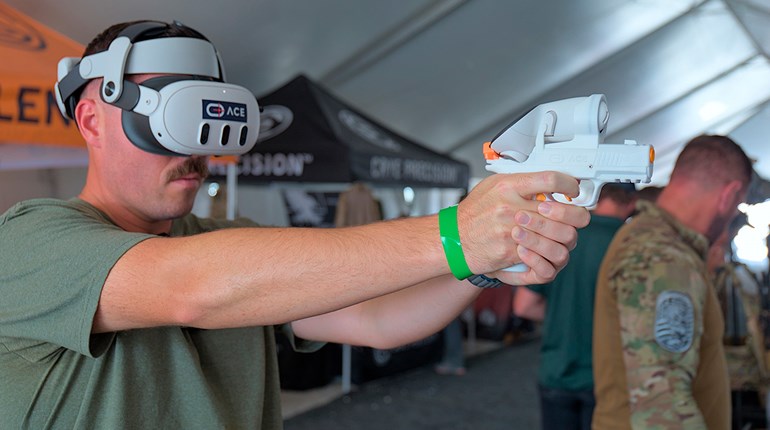
There are some strong opinions about dry fire and its practicality, or how it transfers to “the real world.” Some misconceptions about the purpose of dry fire persist, even among minds that should understand the role repetition plays in building muscle memory. When we use a tool or perform a skill under pressure, we tend to revert to what we have practiced. Let’s talk about what good can come from dry fire work and the pitfalls to avoid.
Repetition
Repetition is the building block for any skill. We cannot do something well, much less perform flawlessly, if we do not have enough repetition of that task.
Why? Any action that we take with our body has a physical and neurological component. And what elite athletes and those who teach them will tell you is that memory isn’t an ethereal concept—it’s a physical fact. When you repeat an action thousands of times, you are literally building a physical path; you are making and building connections in your brain.

You can also say that while learning is a theoretical construct, only the effects of what we learn are measurable. This is very simple really. Learning in and of itself is never actually measured. What we can measure are outcomes. Such as the outcome on a test for someone who reads the required material and attends class. But we can’t actually measure learning in and of itself. And some argue that tests are just a measure of test-taking ability over actual mastery of information. One way humans CAN see learning is by measuring activity in the brain. Still, we can only say that certain areas are active; we can’t say that the person has mastery of information or the ability to apply it.
How does all that relate to dry fire? Well, scientists know that repetition of skills, repeated intake of information, repeated performance of skills, will allow our brains and bodies to “hard-wire” responses. You can think of learning like building connections.
“It is generally agreed that learning occurs when the acquisition of new information causes synaptic changes … Several theories have been proposed … it is thought that any two cells or systems of cells that are repeatedly activated at the same time will tend to become "associated," so that activity in one makes it more likely the other will become active. Repeated co-activation of connected cells is thought to make physical changes in the brain—such as the development of new synapses between neurons or more receptors in the post-synaptic membrane—that lead to a lasting memory.
Another theory ascribes learning to the strengthening of existing synapses. It is thought that the developing brain overproduces synapses early in life. Subsequently experience, by activating certain nerve cells repeatedly and ignoring others, determines which synapses become mature and stable and which ones wither away in a process of synaptic pruning. Over time, this process leaves us with only highly functional synapses. Learning and memory are thought to result when repeated stimulation of sets of neurons causes the communication across synapses to be strengthened, a condition called long-term potentiation.” (newswise.com)
It is a fact that repetition is required to cement a task, to hardwire it in our brain. How much repetition? Well, “In terms of repetition, it is estimated that it takes 10,000 repetitions to master a skill and develop the associated neural pathway.”
So to start, skills need repetition. Who has 10K rounds of ammo to practice just their draw? Or their “prep and press” of the trigger? Or their transition from one target to another? The logistics of tens of thousands of rounds to perfect and cement the neural pathways to mastery of a skill with firearms quickly leads the critical thinker to look at dry fire techniques. This can be a way to increase learning and development of skills without expending tens of thousands of rounds of ammunition. (It’s also easier on the body, in regard to hearing and your joints absorbing recoil, etc.)

“We fall to the level of our training.”
There is a quote many who teach firearms skills like to reference. “We don't rise to the level of our expectations, we fall to the level of our training.” The origin of this quote is traced back to ancient Greece and Greek lyrical poet, Archilochus.
The reason that people like to apply this quote to practice with firearms (or any martial art) is that it highlights the human brain’s likelihood to default to our habits. Default to what we know, the muscle memory or repetition that we have built up is what will likely be our “default” mode.
Rising to expectations is a moral idea. It means, though, that we would go outside of what we might normally default to. It means overriding habits or that might come easily. It implies an “above and beyond.”
But executing a skill, especially if our conscious mind is otherwise occupied, executing skills in a “fight or flight” mode means we are probably not going to “rise.” Our body and mind are going to find the shortest, fastest path to execute an action. If we’ve scribed a path of repetition so deeply that we could do something in our sleep…that increases the likelihood we can react properly without thinking. This is also the danger!
Danger in Familiarity
We are comfortable when things are familiar. We execute basic tasks for example, sitting in a chair, without practice. We know where our body is and we can see a chair. Experience teaches us to expect it to be underneath us when we sit down. We could execute that skill without thinking.
However remove your vision or introduce a variable you are not expecting (e.g. complete darkness) then we are going to default to what we know—the way we would sit in whatever chair/height with which we are most familiar.
Take that disorientation level and apply it to a situation with the need to use lethal force … It can be disorienting to have to focus on a threat, to assess what you see, hear, and feel AND use a firearm or other tool with skill.
If people default to what they know, and their default when someone broke into their house was to rack a round into the chamber and shoot, this could lead to serious mistakes. What if it’s their child coming home late and trying to sneak in?!
What if their default was to shoot and immediately rack the slide? (the worry of some who don’t like the idea of dry fire) They could waste valuable time, or they could stop engaging a threat and get killed. This concern is also a little silly, since most people who work with dry fire in a serious manner for the purpose of bettering specific skills are not mindlessly racking their firearm and pulling the trigger on repeat. They are generally not just working on a draw and the first trigger pulls.
So how do you use repetition of skills with dry fire without leaving yourself open to the potential to “default” to something that will “get you killed on the streets”? It’s pretty simple honestly. Practice the skill or action that you want to be your default.
Set up your dry fire in a way that will help you default to good habits.
Here are some suggestions:
Draw: Practice drawing from where you actually carry. *Note only do this with an unloaded firearm and no ammunition present. Always confirm an empty firearm empty magazines, and follow the rules of firearm safety.
Reload: Practice maintaining your vision downrange. Don’t lose sight of your target. Keep your firearm up in front of you. Practice reloading without looking down for your magazine.
Moving with a firearm: Practice any sort of shooting on the move with a goal in mind. Perhaps that’s moving to the nearest cover. Perhaps you want to practice competition reloading and the goal is to perform the reload within two steps of leaving a position. Maybe the goal is just to walk without seeing your sights “dip” as you step and keeping your sights aligned as you move. Whatever you do, have very specific goals.
What Live Fire Hides
Another facet of dry fire is that some mistakes people make while shooting, such as slapping the trigger, are best seen without recoil. It’s why some trainers add dummy rounds to a student’s magazine—they will see the gun and sights move off the target as they yank on the trigger. So dry fire has the capacity to show you mistakes you are making. Your focus should be to instill habits that are mistake-free.

Finding Balance
In reality, we are always learning and can always improve our skills with firearms. And as mistake-free as the best competitive shooter is, they always have some facet of their skills on which they can improve. For the average gun owner, who doesn’t have the time or ammo to repeat tens of thousands of rounds of live fire, dry fire is a viable option and a tool that CAN help you. Being mindful in the process and building muscle memory is a must.
It is inevitable that the person who practices mag changes as they begin movement out of position with dry fire might just go to their match and change mags when they don’t mean to. It’s a sign that they practiced that skill until their brain hard-wired a mag change into their initiation of movement out of position. There’s no danger there aside from adding to your time or performing a reload in the wrong part of a stage plan.
But if you practice a skill so much that your body takes over and you stop thinking, that’s where you need to find a balance. Our thoughts initiate our actions. So we have to learn to focus consciously, even when our subconscious takes over.
Practice that includes changes, with others giving us scenarios, with some variables to prod us to make conscious decisions SHOULD be a part of any dry fire routine so that we do not train ourselves to perform actions when we don’t intend to.
Intention is under our control most of the time, but even seasoned competitors will tell you how they automatically did something that was maybe an old habit or holdover from using a different firearm platform. The only thing to override bad habits is to replace them with good ones. So be conscious of what you do with dry fire. Purposefully build good habits. And set yourself up so that dry fire training builds default actions that help you, instead of hinder.














































